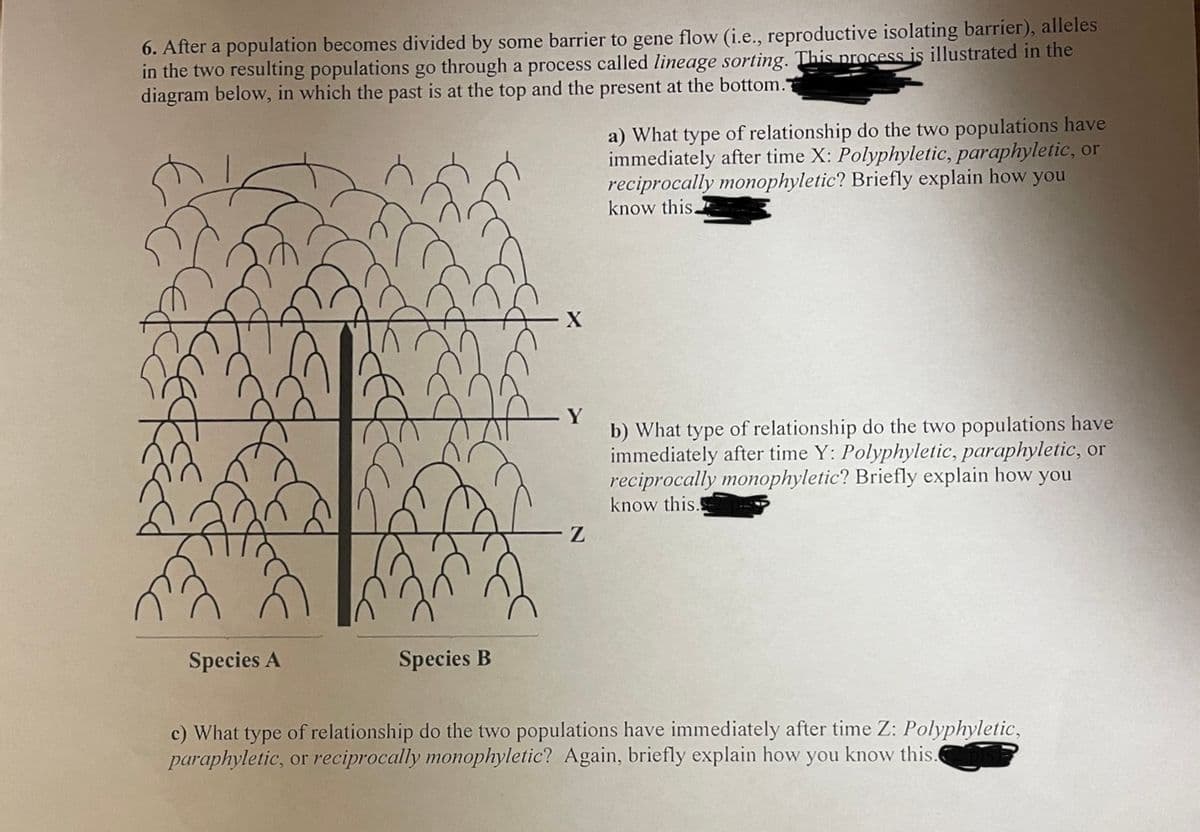c) What type of relationship do the two populations have immediately after time Z: Polyphyletic, paraphyletic, or reciprocally monophyletic? Again, briefly explain how you know this.
c) What type of relationship do the two populations have immediately after time Z: Polyphyletic, paraphyletic, or reciprocally monophyletic? Again, briefly explain how you know this.
Biology 2e
2nd Edition
ISBN:9781947172517
Author:Matthew Douglas, Jung Choi, Mary Ann Clark
Publisher:Matthew Douglas, Jung Choi, Mary Ann Clark
Chapter19: The Evolution Of Populations
Section: Chapter Questions
Problem 7RQ: One of the original Amish colonies rose from a ship of colonists that came from Europe. The ship s...
Related questions
Question
Only answer question c please

Transcribed Image Text:6. After a population becomes divided by some barrier to gene flow (i.e., reproductive isolating barrier), alleles
in the two resulting populations go through a process called lineage sorting. This process is illustrated in the
diagram below, in which the past is at the top and the present at the bottom.
a) What type of relationship do the two populations have
immediately after time X: Polyphyletic, paraphyletic, or
reciprocally monophyletic? Briefly explain how you
know this.
X
b) What type of relationship do the two populations have
immediately after time Y: Polyphyletic, paraphyletic, or
reciprocally monophyletic? Briefly explain how you
know this.
Z
Species A
Species B
c) What type of relationship do the two populations have immediately after time Z: Polyphyletic,
paraphyletic, or reciprocally monophyletic? Again, briefly explain how
you
know this.
Expert Solution
This question has been solved!
Explore an expertly crafted, step-by-step solution for a thorough understanding of key concepts.
Step by step
Solved in 2 steps

Knowledge Booster
Learn more about
Need a deep-dive on the concept behind this application? Look no further. Learn more about this topic, biology and related others by exploring similar questions and additional content below.Recommended textbooks for you

Biology 2e
Biology
ISBN:
9781947172517
Author:
Matthew Douglas, Jung Choi, Mary Ann Clark
Publisher:
OpenStax

Biology: The Dynamic Science (MindTap Course List)
Biology
ISBN:
9781305389892
Author:
Peter J. Russell, Paul E. Hertz, Beverly McMillan
Publisher:
Cengage Learning

Biology: The Unity and Diversity of Life (MindTap…
Biology
ISBN:
9781305073951
Author:
Cecie Starr, Ralph Taggart, Christine Evers, Lisa Starr
Publisher:
Cengage Learning

Biology 2e
Biology
ISBN:
9781947172517
Author:
Matthew Douglas, Jung Choi, Mary Ann Clark
Publisher:
OpenStax

Biology: The Dynamic Science (MindTap Course List)
Biology
ISBN:
9781305389892
Author:
Peter J. Russell, Paul E. Hertz, Beverly McMillan
Publisher:
Cengage Learning

Biology: The Unity and Diversity of Life (MindTap…
Biology
ISBN:
9781305073951
Author:
Cecie Starr, Ralph Taggart, Christine Evers, Lisa Starr
Publisher:
Cengage Learning